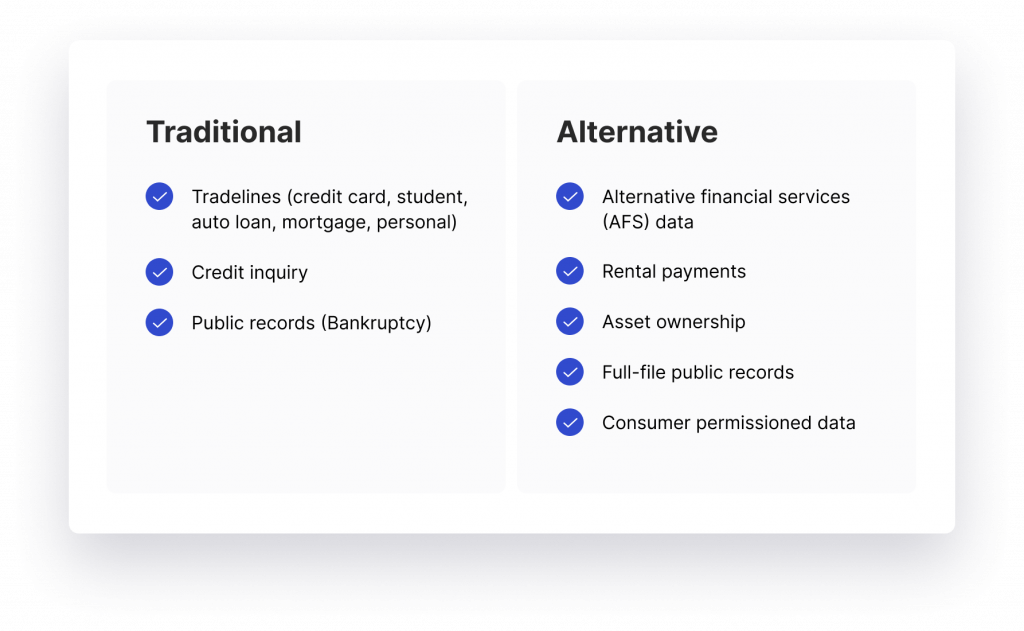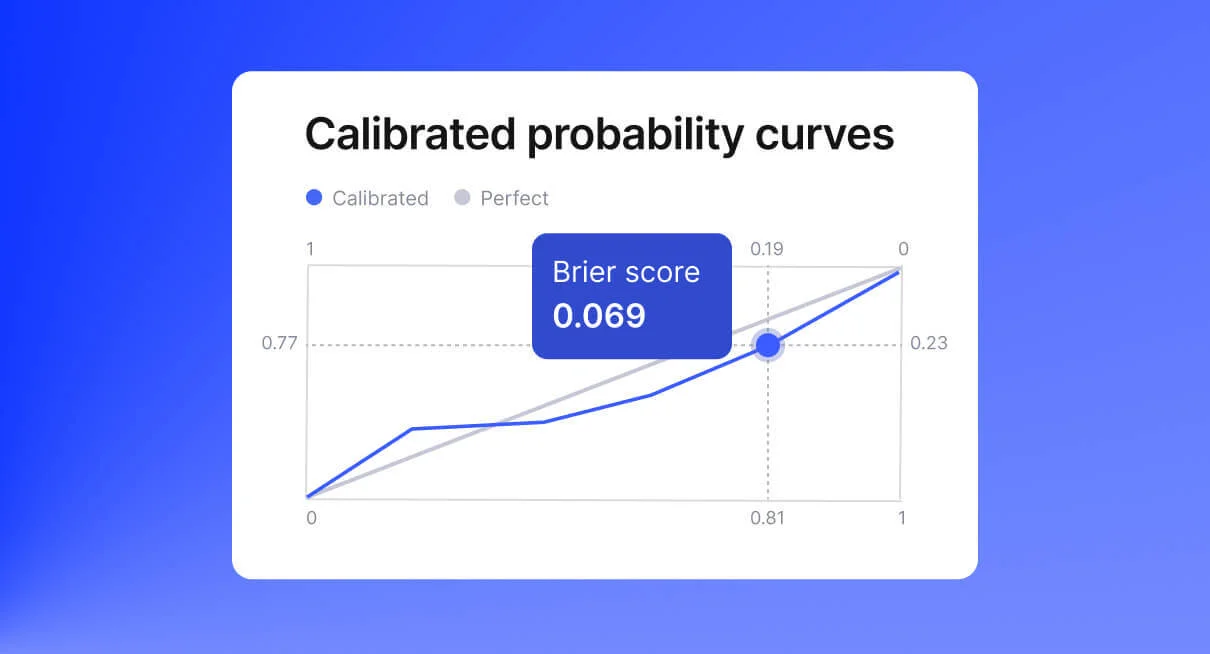Traditional Vs. Alternative Credit Scoring: Differences and Advantages

Credit scoring is a method used to determine the creditworthiness of an individual or organization. Traditionally, it utilizes factors such as credit history and financial history, among others, to evaluate how likely the borrower is to default on their payment. The problem is the current credit scoring models don’t work for everyone.
Today, over 28 million Americans are credit invisible, in addition to another 21 million who are deemed unscorable. Such statistics suggest one thing—traditional credit scoring doesn’t work. In the past, lenders relied heavily on credit bureaus to deliver credit scores. Now, there is another solution—alternative credit scoring. This method expands upon traditional credit scoring models and incorporates factors such as non-traditional data such as utility and rent payments, social media activity, or other behavioral patterns.
Let’s take a look at these traditional credit scoring models and how new alternatives could improve them.
What is a credit scoring model and what types are available?
Simply put, a credit scoring model is a statistical algorithm that helps lenders assess the likelihood of a client defaulting on their payments, and evaluates their overall ‘creditworthiness.’ Today, numerous credit scoring assessment models exist—both traditional and alternative. These are some of the most popular:
- FICO—most widely-used credit scoring model. Draws on information from TransUnion, Equifax, and Experian to deliver results.
- VantageScore—similar to the FICO, this model is primarily used within the United States.
- Credit Karma—allows consumers are credit monitoring services to receive credit scores for free via their website.
- TransRisk Score—utilizes alternative data, including rental payments and employment history to give a credit score.
- Experian’s PLUS Score—draws from additional factors such as payment history, credit utilization, and length of credit history.
- Equifax Credit Score—calculates credit scores by utilizing data from the uses Equifax credit bureau.
How do traditional credit scoring models work?
Not much has changed since the traditional credit scoring models that we use today were introduced back in 1989 by Bill Fair, Earl Isaac, and Company, who created the FICO model. When asked, “what is a credit scoring system?” The FICO model is the standard that lending organizations think of. Let’s take a look at how it is calculated:
- Payment history (35%)—essentially how frequently a borrower makes payments on time. Accounts for missed or late payments.
- Amounts owed (30%)— how much a borrower owes, includes credit card balances, loans, and mortgages.
- Length of credit history (15%)—how long a borrower has had credit accounts. Including age of their oldest account and the average age of all their accounts.
- Credit mix (10%)—examines types of credit accounts a borrower has—credit cards, loans, and mortgages.
- New credit (10%)—evaluates the number of recently opened credit accounts and credit applications. Also looks at the borrower’s overall credit history.
These factors are fairly standard, in varying proportions across many credit scoring models. Most take into account, at minimum, payment history, credit utilization, length of credit history, new credit inquiries, and other factors. These will be used to deliver a credit score. For example, up to 300, up to 800, 900, etc., which shows a client’s creditworthiness. The higher the score, the more likely they are to be offered credit and more favorable loan terms.
What is alternative credit scoring and why it matters?
Tried and tested, true and blue, traditional credit scoring has served well enough for the past 30 years; why shouldn’t it continue to do so? Fact is. It hasn’t. Aside from the 28 million credit-invisible Americans, countless others across the world have difficulties accessing credit.
In part, this is due to how finances as a whole have evolved. The Gen Z and Millennial generations, accounting for a now significant amount of buying power, simply interact with finances differently to previous generations. This complex subject can be chalked up to a variety of factors, including the 2008 recession, the housing crisis, debt levels, the gig economy, the rise of digital banking, and many more. Together creating difficulties in accessing financing and the need for a solution.
Enter alternative credit scoring models. These are a variety of alternative ways to calculate creditworthiness, such as industry-specific models, custom models, AI technology, and more.

Non-traditional data sources
Social media profiles, online behavior, mobile usage, online shopping and more. Alternative credit scoring models can draw on these factors to help more accurately determine credit risk and predict future borrowing behavior.
Machine learning algorithms
By analyzing large amounts of data—past behavior, loans, debts, repayments, etc.—trends and patterns can be identified within a borrower’s history that may signal risk. Organizations can draw upon these to enhance the quality of their credit scores.
Third-party collaboration and tools
Utility companies, rental agencies, and other providers are excellent sources of data about a borrower’s payment history. Being able to effectively collaborate allows a new layer of analysis into how that individual or business repays or pays for services over a period of time. Essentially indicating how responsible they are in day-to-day interactions.
Customized models for specific populations
Self-employed, younger, older, relocated, issues in the past, all these can be factors that can cause borrowers to be turned down for loans, whereas they may otherwise be creditworthy. By tailoring credit scoring models to certain population groups, more accurate results can be achieved that allow for companies to have increased confidence when lending.
Note that although these factors can be utilized to identify credit risk, that can conversely be used for the opposite purpose as well—lending opportunity. By understanding risk more accurately, lending organizations can often afford to deliver tailored rates and terms to clients, increase the number of loans made, and even identify new client markets.
What is a credit scoring system unwrapped?
A credit scoring system is a tool that lenders and financial institutions use to assess the creditworthiness of potential borrowers. Usually, this is rated on a numerical scale (300, 800, 900, etc.) using statistical algorithms, which are based on traditional credit scoring models.
However, in recent years, more and more companies are choosing to explore the potentials of alternative credit scoring. By taking advantage of additional data, lending organizations can increase their confidence that the decisions they are making are based more on today’s reality than past credit ideals. By doing so, such lenders and institutions can access new markets and unlock new customer segments in the ever-competitive financial arena.
Convinced that alternative credit scoring is the way forward? Want to see it in action? Try GiniMachine and explore the possibilities for your organization in real time.



